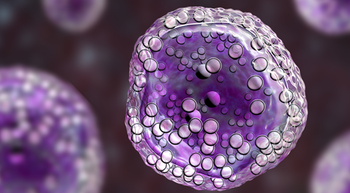
- May 2018
- Volume 12
- Issue 4
Benefits of Yoga and Meditation for Patients With Cancer
Yoga is a complementary mind–body therapy that may help people manage cancer symptoms or adverse effects of treatments and improve their quality of life.
Yoga is a complementary mind—body therapy that may help people manage cancer symptoms or adverse effects of treatments and improve their quality of life. The summary of research from the National Center for Complementary and Integrative Health on mind–body interventions suggests that yoga may help with anxiety, depression, distress, and stress in people with cancer.1 Results of studies of patients with early-stage breast cancer and survivors suggest that yoga may help to reduce fatigue. Meditation, one of the tools of yoga, has similarly been shown to address anxiety, stress, fatigue, and general mood and sleep disturbances.1
Yoga is a synergistic system of knowledge and practices grounded in ancient Indian philosophy, with a goal of stilling the fluctuations of the mind and developing physical, mental, and emotional equanimity.2 It is widely popular in the United States: As of 2012, 9.5% of US adults had reported using yoga, with 8% using meditation.3
Physically challenging styles of yoga are less appropriate for patients with cancer coping with health challenges than are hatha, yin, therapeutic, and Viniyoga. Viniyoga adapts the tools of yoga (breath, movement, meditation) to the needs, goals, and abilities of the individual.2,4-6 There is a continuum, ranging from group classes to individual yoga therapy, in which the therapist customizes and supports a program for the client.7,8
CLINICAL ONCOLOGY GUIDELINES
Clinical oncology practice guidelines based on a systematic literature review from 1990 through 2015 detail a growing body of evidence for recommending mind—body therapies as supportive breast cancer care during and after treatment. Specifically, yoga and meditation appear to be highly or moderately helpful for reducing anxiety and stress, improving depression and mood disorders, and enhancing quality of life.9
A review of 11 randomized clinical trials (RCTs) and 6 non- RCTs found consistent support from the efficacy of yoga to improve mental health outcomes (such as distress, mood and anxiety) during cancer treatment. Some research found improvements in sleep, fatigue, and quality of life during treatment.10 A review of 9 RCTs and 6 nonrandomized studies of yoga use by cancer survivors suggests physical and psychosocial benefits. Preliminary findings show potential relief from fatigue, dyspnea, gastrointestinal issues, menopausal symptoms, pain severity, and improvements in respiratory function, heart rate, and HRV, as well as sleep-related benefits, emotional well-being, vigor, stress, and cognitive functioning.11
YOGA CHANGES HOW THE MIND FUNCTIONS
Neuroscience and psychology show that the default state of the human brain is mind wandering—ruminating about the past or thinking about the future.12-14 Yoga and meditation shift attention to the interoceptive neural network by directing attention to present-moment interoceptive bodily sensations such as breath. Genetics and life experiences contribute to individual capacity for interoceptive awareness.15 That capacity can improve with training. Regular practice develops an attentional habit and capacity to direct attention to interoceptive sensations.16-18 An increased capacity and propensity to direct attention to bodily sensations (interoceptive awareness) promotes emotional and bodily awareness. In other words, we notice how we are feeling when we get triggered, making it more likely we will make different choices, such as stop and take a deep breath, think and then respond, rather than just react.
SELF-REGULATION HELPS MAINTAIN PHYSICAL AND EMOTIONAL BALANCE
Self-regulation is “our ability to control how we feel and act.”19 What self-regulation of bodily tries to do is to maintain homeostasis; and self-regulation of emotional states helps us maintain equilibrium, or balance. Interoception and bodily states are inseparable; interoception and emotional states are inseparable. The autonomic nervous system continuously makes metabolic and vascular adjustments to try to maintain homeostasis (and keep us alive). Conscious awareness of bodily states (through interoception) alerts our mind to make changes in the body or our environment to maintain homeostasis. Good emotional awareness means that someone detects bodily signals and can clearly differentiate how each emotion feels. That awareness enables that person to take steps to alter emotions or situations to maintain, increase, or decrease an emotion.15,19
EFFECTS OF YOGA
Practicing yoga regularly can potentially support change in the way the mind and body function:
- Inhibiting cognitive, emotional, and behavioral stress responses (such as negative self-appraisal, emotional reactivity, and rumination)
- Inhibiting autonomic stress responses (such as vasopulminary constriction, inflammation, and muscle tension and pain)
- Facilitating viscerosomatic processing of sensory— motor signals20
Another theoretical mechanism of yoga effects is that breath regulation (pranayama) during yoga practices improves vagal nerve tone. The vagus nerve contains the main bidirectional perceptual pathway of the parasympathetic nervous system (PNS). Practicing yoga shifts regulatory systems toward optimal homeostasis, reducing allostatic load and correcting underactivity of the PNS and γ-aminobutyric acid systems.21 Allostatic load is the cost to the body of maintaining stability during reactions to chronic stress (such as high blood pressure and elevated heart rate). In this way, yoga supports the functioning of the autonomic nervous, neuroendocrine, hypothalamic-pituitary- adrenal axis, cardiovascular, metabolic, and immune systems and influences emotional states and thought processes.21
ADVICE FOR PATIENTS WITH CANCER
Yoga interventions are noninvasive, low cost, and can be adapted for people who have functional or other impairments. Selecting an appropriate style of yoga and an experienced, certified instructor will minimize potential risks of harm for people undergoing cancer treatment, including elderly patients and those with limited mobility. Knowledgeable, experienced yoga teachers often offer private sessions adapted for the individual that can be practiced at home. Certified yoga therapists are trained to deliver individualized therapeutic yoga.22,23
Carrie Heeter, PhD is a professor of media and information at Michigan State University. She designs and researches cybermeditation. She is a certified Viniyoga and meditation teacher. Heeter has studied meditation one-on-one for 5 years with her teacher, Marcel Allbritton, PhD.Rebecca Lehto, PhD, RN is an associate professor at Michigan State University College of Nursing. Her research focuses on symptom management and adaptation to cancer.
REFERENCES
- Cancer: In Depth. National Center for Complementary and Integrative Health. 2017 [cited 2017 Dec 13]. Available from: nccih.nih.gov/health/cancer/complementary-integrative-research. Accessed March 29, 2018.
- Desikachar TKV. The Heart of Yoga: Developing a Personal Practice. Revised edit. Rochester, VT: Inner Traditions; 1999:244.
- Clarke T, Black L, Stussman B, Barnes P, Nahin R. Trends in the use of complementary health approaches among adults: United States, 2002—2012. National health statistics reports; no 79. Hyattsville, MD: Stussman. 2015. Hyattsville, MD: National Center for Health Statistics; 2015. (National Health Statistics Reports). Report No.: 79. nccih.nih.gov/research/statistics/NHIS/2012/mind-body/yoga#pdf. Accessed March 29, 2018.
- Desikachar TKV. The Viniyoga of Yoga: Applying Yoga for Healthy Living. 1st Edit. India: Quanda Press Limited; 2001: 391.
- Desikachar K, Bragdon L, Bossart C. The yoga of healing: Exploring yoga’s holistic model for health and well-being. Int J Yoga Ther. 2005;15(1):17—39.
- Mohan AG, Mohan I. Yoga Therapy: A Guide to the Therapeutic Use of Yoga and Ayurveda for Health and Fitness. Boston, MA: Shambhala; 2004.
- Chandrasekaran N. Principles and Practice of Yoga Therapy: A Complete Gguide for Learning and Practice of Yoga Therapy. Chennai, India: VHP Publications; 2012.
- Contemporary Definitions of Yoga Therapy - International Association of Yoga Therapists (IAYT). [cited 2017 Feb 5]. iayt.org/?page=ContemporaryDefiniti. Accessed March 29, 201
- Greenlee H, DuPont-Reyes MJ, Balneaves LG, Carlson LE, Cohen MR, Deng G, et al. Clinical practice guidelines on the evidence-based use of integrative therapies during and after breast cancer treatment. CA Cancer J Clin. 2017 67(3):194—232.
- Danhauer S, Sohl S, Addington E, Chaoul A, Cohen L. Yoga Therapy During Cancer Treatment: Clinical insights. In: The Principles and Practice of Yoga in Health Care. Endenburgh: Handspring Publishing; 2016. p. 339—74.
- Culos-Reed S, Long R, Walter A, Van Puymbroeck A. Yoga Therapy for Cancer Survivors: Clinical insights. In: The Principles and Practice of Yoga in Health Care. Endenburgh: Handspring Publishing; 2016. p. 375—400.
- Buckner RL, Andrews-Hanna JR, Schacter DL. The brain’s default network: Anatomy, function, and relevance to disease. Ann N Y Acad Sci. 2008;1—38.
- Killingsworth MA, Gilbert DT. A Wandering Mind Is an Unhappy Mind. Science. 2010 Nov 12;330(6006):932—932.
- Mittner M, Boekel W, Tucker AM, Turner BM, Heathcote A, Forstmann BU. When the Brain takes a break: A model-based analysis of mind wandering. J Neurosci. 2014 Dec 3;34(49):16286—95.
- Craig AD (Bud). How Do You Feel? An Interoceptive Moment with Your Neurobiological Self. Princeton, NJ: Princeton University Press; 2014.
- Farb N, Daubenmier J, Price CJ, Gard T, Kerr C, Dunn BD, et al. Interoception, contemplative practice, and health. Conscious Res. 2015 [cited 2015 Jun 19]. journal.frontiersin.org/article/10.3389/fpsyg.2015.00763/abstract. Accessed March 29, 2018.
- Farb N, Segal Z, Anderson AK. Mindfulness meditation training alters cortical representations of interoceptive attention. Soc Cogn Affect Neurosci. 2012;8(1).
- Brewer JA, Worhunsky PD, Gray JR, Tang Y-Y, Weber J, Kober H. Meditation experience is associated with differences in default mode network activity and connectivity. Proc Natl Acad Sci. 2011 Dec 13;108(50):20254—9.
- Mahler KJ. Interoception: The Eighth Sensory System. AAPC Publishing; 2015.
- Gard T, Noggle JJ, Park CL, Vago DR, Wilson A. Potential self-regulatory mechanisms of yoga for psychological health. Front Hum Neurosci. 2014;8:770.
- Streeter CC, Gerbarg PL, Saper RB, Ciraulo DA, Brown RP. Effects of yoga on the autonomic nervous system, gamma-aminobutyric-acid, and allostasis in epilepsy, depression, and post-traumatic stress disorder. Med Hypotheses. 2012;78(5):571—9.
- Find a Certified Yoga Therapist. www.iayt.org/search/custom.asp?id=4160. Accessed March 29, 2018.Dec 16, 2017. Accessed March 29, 2018.
- International Association of Yoga Therapists. Educational Standards for the Training of Yoga Therapists. International Association of Yoga Therapists. c.ymcdn.com/sites/www.iayt.org/resource/resmgr/accreditationmaterials/2017_11_Updates-Ed_Stds/2017_IAYT_Educational_Standa.pdf. Published September 1, 2017. Accessed March 29, 2018.
Articles in this issue
over 7 years ago
AKT Inhibitor May Overcome Chemotherapy Resistance in TNBCover 7 years ago
Novel Combo Explored for Rare Brain Tumorover 7 years ago
Bioimpedance Spectroscopy Can Help Prevent Clinical Lymphedemaover 7 years ago
Is It OK for an Oncology Nurse to Attend a Patient's Funeral?over 7 years ago
How to Advise Patients About Direct-to-Consumer Genetic Testingover 7 years ago
The Day Plannerover 7 years ago
Battling Bedbugs in the Infusion Centerover 7 years ago
An Ounce of Prevention: Cancer Prehabilitation

















































































